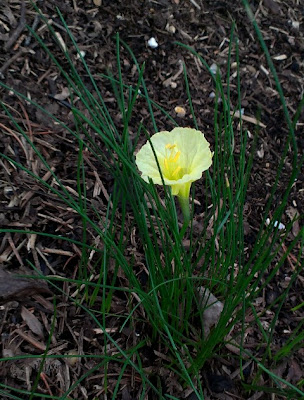All is not vanity, but avoid being trapped in a small space with a daffodil
Uncharacteristically I heard someone in London say this week that spring was around the corner. Mostly the talk here is of dreary days and longer nights. Daffodils may offer some hope but not, I hasten to add, in a confined space.
This particular daffodil, Narcissus romieuxii from Morocco, flowers smack in the middle of winter but you can't help but think of it as the end of the wick leading to spring. At least this is far more satisfying that seeing it as a outlier from the previous summer or just something to keep viburnums and mahonias company in the depth of winter.
You can see why it's called the Hoop Petticoat Daffodil. The typical bell-shaped part of a daffodil flower, the corona, resembles and blows about like a old-fashioned petticoat. There are few daffodils like this, mostly in the Section Bulbocodium.
Narcissus bulbocodium and its relatives are mostly found around the Mediterranean. My featured species comes from the Atlas Mountains in Morocco. There are forms that flower in November, supporting what might be called the summer dregs theory I'm afraid. But they do have a long flowering period, continuing into late winter.
The leaves of Narcissus romieuxii are fine and tough, which makes sense for a winter specialist. The flowers, however, are dainty and look like they wouldn't survive a heavy frost. In fact the RHS recommend growing this species in an alpine house rather than exposed in a rockery.
The Alpine Garden Society take a different tack. While they acknowledge the wind and rain of a 'typical English winter' will bash the flower around a bit, they find it tolerates severe frost. The important thing, and I've read this elsewhere, is to make sure it dries out thoroughly in summer. For London, this means lifting the bulbs or growing under glass. Here at Kew Gardens Narcissus romieuxii is doing nicely under a deciduous tree in the Woodland Garden (I didn't notice if our staff borrowed the bulbs for a summer dessication).
And what about this generic name Narcissus. Sounds like someone is rather fond of themselves, or perhaps fond of illegal substances. The definition you often see is after the beautiful youth who is so entranced with his reflection the gods turn him into a flower, that flower being a daffodil. You may also find references to the narcotic qualities of the daffodil bulb and the numbness (narke in Ancient Greek or narce in Latin) they can cause.
The bulb is indeed poisonous in many species (a common attribute of things containing narcotics). While generally a little sceptical of such things, the online A Modern Herbal says that Pliny in 77 AD describes the daffodil as 'named Narcissus from Narce, not from the fabulous boy'. I checked this in my office (yes I do have a few Pliny volumes on my bookshelf) and can confirm that narce narcissum dictum, non a fabuloso puero (book 21, chapter 75; although an on-line version I found later directs me to chapter 74...).
The daffodil was given its official scientific name in the 17th century, by Carl Linnaeus, and it seems reasonable to presume he appropriated this from Roman moniker. So we can safely follow Pliny on this one.
I do find herbals entertaining, if not always instructive, and I like the reference in A Modern Herbal to Socrates calling the daffodil 'chaplet of the infernal gods' due to it numbing wounds and in some cases paralysing the heart. A chaplet is a string of beads or a wreath worn around the head.
In the UK daffodils are usually harmless fun, although by mid-spring they can be a little overwhelming in number. Still, whether they represent a dangerous floral high, the optimism of an early spring or a resilience to London's winter, the early daffodils are a welcome flower in January.
Images: I blame the weak English light and my phone camera for the rather substandard photograph at the top; at least it's evidence of a flower, outdoors, in London, in January. The second photo is borrowed from the St Andrews Botanic Garden website, where it was plant of the month a year ago. This is an informative webpage, citing the lovely warning that 'if you are trapped in a small space with a daffodil, it will give you a headache'. This helpful advice, from the BBC Homepage originally, also advises against eating the bulbs or applying them to an open wound.


Comments
I started to hate the smell and got headaches so I came around looking up on the internet and found the following :- ‘ Picking the flowers can cause a form of dermatitis called “daffodil itch,” resulting from absorption of lycorine and other alkaloids, calcium oxalate, and chelidonic acid. Even smelling daffodils can cause headaches and vomiting in pets and sensitive people.Mar 24, 2018‘.
Out doors went the daffs....have not had time to assess the results but will do soon.